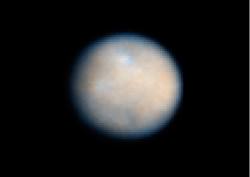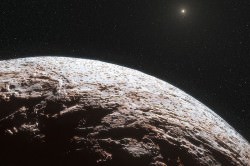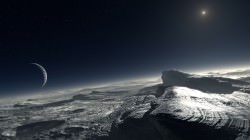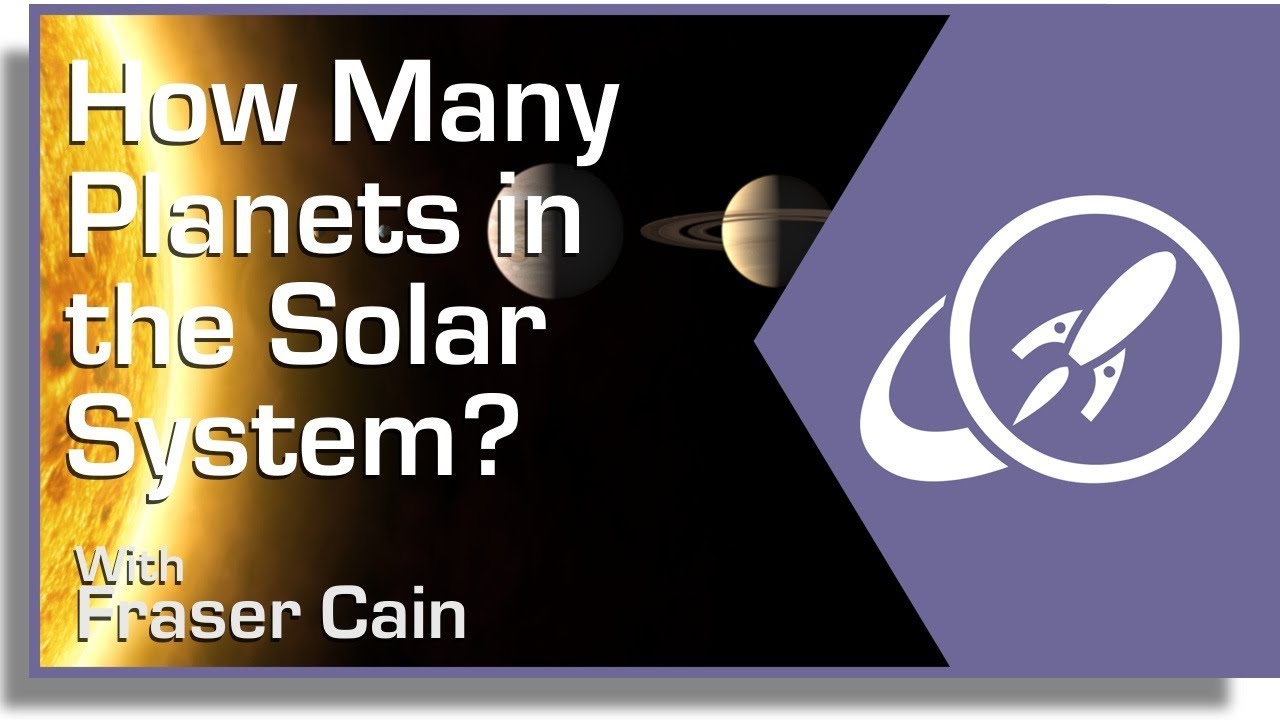I’m just going to warn you, this is a controversial topic. Some people get pretty grumpy when you ask: how many planets are in the Solar System? Is it eight, ten, or more?
I promise you this, though, we’re never going back to nine planets… ever.
When many of us grew up, there were nine planets in the Solar System. It was like a fixed point in our brains.
As kids, memorizing this list was an early right of passage of nerd pride: Mercury, Venus, Earth, Mars, Jupiter, Saturn, Uranus, Neptune and Pluto.
But then in 2005, Mike Brown discovered Eris, an icy object thought to be about the same size as Pluto, out beyond its orbit.
That would bring the total number of planets to ten. Right? There’s no turning back, textbooks would need to be changed.
In order to settle the dispute, the International Astronomical Union met in 2006, and argued for, and against Pluto’s planethood. Some astronomers advocated widening the number of planets to twelve, including Pluto, its moon Charon, the Asteroid Ceres, and the newly discovered Eris.
In the end, they changed the definition of what makes a planet, and sadly, Pluto doesn’t make the cut:
Here are the new requirements of planethood status:
- A planet has to orbit the Sun. Okay fine, Pluto does that.
- A planet needs enough gravity to pull itself into a sphere. Okay, spherical. Pluto’s fine there too.
- A planet needs to have cleared out its orbit of other objects. Uh oh, Pluto hasn’t done that.
For example, planet Earth accounts for a million times the rest of the material in its orbit, while Pluto is just a fraction of the icy objects in its realm.
The final decision was to demote Pluto from planet to dwarf planet.
But don’t despair, Pluto is in good company.

Haumea, named after the Hawaiian goddess of fertility, is about a third the mass of Pluto, and has just enough gravity to pull itself into an ellipsoid, or egg shape. Even though it’s smaller, it’s got moons of its own.

Eris is the most massive known dwarf planet, and the one that helped turn our definition of a planet upside-down. It’s 27% more massive than Pluto and the ninth most massive body that orbits the Sun. It even has a moon: Dysnomia.

Want an easy way to remember the eight planets, in order? Just remember this mnemonic: my very excellent mother just served us noodles.
For all you currently writing angry tweets to Mike Brown, hold on a sec. Changing Pluto’s categorization is an important step that really needed to happen.
The more we discover about our Universe, the more we realize just how strange and wonderful it is. When Pluto was discovered 80 years ago, we never could have expected the variety of objects in the Solar System. Categorizing Pluto as a dwarf planet helps us better describe our celestial home.
So, our Solar System now has eight planets, and five dwarf planets.


There are 12 planets in the solar system–Mercury, Venus, Earth, Mars, Ceres, Jupiter, Saturn, Uranus, Neptune, Pluto, MakeMake, and Eris. It’s not the International Astronomical Union but four percent of that group that voted on excluding Pluto in a sloppy, nonsensical definition that states a dwarf planet is not a planet at all. The requirement that an object clear its orbit to be considered a planet is vague and if applied literally, could exclude all the planets because none has fully cleared its orbital field of nearby asteroids, and Neptune has not cleared its orbit of Pluto.
Most of the 424 IAU members who voted on this are not planetary scientists. No absentee voting was allowed. Also, many planetary scientists are not members of the IAU and therefore had no say in this matter.
Interestingly, almost as many astronomers as those who voted at the IAU General Assembly in 2006 signed a petition saying they will not use the new definition, and a better one is needed. The lead scientist rejecting the IAU decision is Dr. Alan Stern, Principal Investigator of NASA’s New Horizons mission and one of the foremost experts in the world on Pluto and the Kuiper Belt.
An object orbiting the sun with enough self-gravity to pull itself into a round shape (a condition known as hydrostatic equilibrim) is a planet. With this definition, we keep the term planet as broad as possible while allowing for multiple subcategories such as terrestrial planet, gas giant, ice giant, dwarf planet, hot Jupiters, super Earths, etc.
There is no problem with defining a dwarf planet as an object that does not dominate the neighborhood of its orbit. The problem comes in stating that a dwarf planet is not a subtype of planet. This is where the IAU decision falls short and needs to be revised.
This matter will be further discussed in August 2008 at the Great Planet Debate in Laurel, Maryland. More information on this conference, which is open to the public, is available at http://gpd.jhuapl.edu/
It is a disservice to readers to portray the planet question as a done deal as opposed to an ongoing debate. I urge you to present both sides of this debate as opposed to choosing one view and presenting it as a foregone conclusion.
The explanation based on the nine planet:but i suggest that there was jst nine planet in the solar system.how come the eight now in the solar system.joining the three dwarf planet that is the ceres,eris,and the makemake plus the pluto which is not part of the planet agin making twelve planet in the solar system.can u pls give more explanation based on that.send any information to my email box provided below.
I like the comments of Laurel Kornfeld, please let me know the present status of number of planets after the Aug 2008 meeting or any new development in this topic.
Thank you, M. Afzal. You can find the proceedings of the Great Planet Debate–some audio and some video–at this site:
http://gpd.jhuapl.edu/
For those of us who believe dwarf planets should be counted as a subclass of planets, the latest status is that our solar system now has 13 planets: four terrestrial planets, four jovian planets, and five dwarf planets. Haumea, formerly known as 2003EL61, was recognized as a dwarf planet in September. The current order of the planets from the sun is Mercury, Venus, Earth, Mars, Ceres, Jupiter, Saturn, Uranus, Neptune, Pluto, Haumea, Makemake and Eris–with more dwarf planets likely to come.
planet shlanet. who cares? as long as no alien is trying to take over my planet then im fine
pls tell me how many planets when you see all of them then send it back to
me and i will never send any bad thing to you even if i wanted to so help me out pretty pls
for me its easy if it orbits the sun and it is in are planetary system making it a planet just because its past the Kuiper belt or in it and small does not make it less of a planet
so for me Pluto Haumea, Makemake, and Eris. Ceres are planets
Laurel Kornfeld I couldn’t agree more. However, what you are calling a planet is actually termed a ‘planemo’, meaning PLANEtary Mass Object. This includes perfect planets AND dwarf planets, as well as moons the size of planets and even interstellar ‘planets’. Pluto, Eris, Haumea, and other dwarf planets, including Ceres, are planemos. You are right; the ‘clearing the neighboorhood’ thing is ABSURD, and I refuse to use the IAU definition of a planet, I will use my own definition (see my second latest comment on ‘why is pluto not a planet/universe today). And I do not agree that a dwarf planet is not a planet even though it is called a dwarf PLANET! Since both planets and dwarf planets are planemos, then they are. Dwarf planets are not between planets and planetoids, they are closer to planets! However, I do believe that perfect planets and dwarf planets are different things. But, as I said, they are two of several subclasses of planemos. And also, I will just add one thing to your definition of planet/planemo: it needs to be massive enough and typically big enough to get into the planetary span (which, however, needs to be defined roughly). All bodies fullfilling this condition would be in hydrostatic equilibrium. Also, I disagree with you that it is OK to define dwarf planet by whether it has cleared its orbit. Didn’t you mention yourself that it is stupid to determine a planet by that criteria (or, rather, the opposite of it)?
Laurel Kornfeld I couldn’t agree more. However, what you are calling a planet is actually termed a ‘planemo’, meaning PLANEtary Mass Object. This includes perfect planets AND dwarf planets, as well as moons the size of planets and even interstellar ‘planets’. Pluto, Eris, Haumea, and other dwarf planets, including Ceres, are planemos. You are right; the ‘clearing the neighboorhood’ thing is ABSURD, and I refuse to use the IAU definition of a planet, I will use my own definition (see my second latest comment on ‘why is pluto not a planet/universe today). And I do not agree that a dwarf planet is not a planet even though it is called a dwarf PLANET! Since both planets and dwarf planets are planemos, then they are. Dwarf planets are not between planets and planetoids, they are closer to planets! However, I do believe that perfect planets and dwarf planets are different things. But, as I said, they are two of several subclasses of planemos. And also, I will just add one thing to your definition of planet/planemo: it needs to be massive enough and typically big enough to get into the planetary span (which, however, needs to be defined roughly). All bodies fullfilling this condition would be in hydrostatic equilibrium. Also, I disagree with you that it is OK to define dwarf planet by whether it has cleared its orbit. Didn’t you mention yourself that it is stupid to determine a planet by that criteria (or, rather, the opposite of it)?
Laurel Kornfeld I couldn’t agree more. However, what you are calling a planet is actually termed a ‘planemo’, meaning PLANEtary Mass Object. This includes perfect planets AND dwarf planets, as well as moons the size of planets and even interstellar ‘planets’. Pluto, Eris, Haumea, and other dwarf planets, including Ceres, are planemos. You are right; the ‘clearing the neighboorhood’ thing is ABSURD, and I refuse to use the IAU definition of a planet, I will use my own definition (see my second latest comment on ‘why is pluto not a planet/universe today). And I do not agree that a dwarf planet is not a planet even though it is called a dwarf PLANET! Since both planets and dwarf planets are planemos, then they are. Dwarf planets are not between planets and planetoids, they are closer to planets! However, I do believe that perfect planets and dwarf planets are different things. But, as I said, they are two of several subclasses of planemos. And also, I will just add one thing to your definition of planet/planemo: it needs to be massive enough and typically big enough to get into the planetary span (which, however, needs to be defined roughly). All bodies fullfilling this condition would be in hydrostatic equilibrium. Also, I disagree with you that it is OK to define dwarf planet by whether it has cleared its orbit. Didn’t you mention yourself that it is stupid to determine a planet by that criteria (or, rather, the opposite of it)?Laurel Kornfeld I couldn’t agree more. However, what you are calling a planet is actually termed a ‘planemo’, meaning PLANEtary Mass Object. This includes perfect planets AND dwarf planets, as well as moons the size of planets and even interstellar ‘planets’. Pluto, Eris, Haumea, and other dwarf planets, including Ceres, are planemos. You are right; the ‘clearing the neighboorhood’ thing is ABSURD, and I refuse to use the IAU definition of a planet, I will use my own definition (see my second latest comment on ‘why is pluto not a planet/universe today). And I do not agree that a dwarf planet is not a planet even though it is called a dwarf PLANET! Since both planets and dwarf planets are planemos, then they are. Dwarf planets are not between planets and planetoids, they are closer to planets! However, I do believe that perfect planets and dwarf planets are different things. But, as I said, they are two of several subclasses of planemos. And also, I will just add one thing to your definition of planet/planemo: it needs to be massive enough and typically big enough to get into the planetary span (which, however, needs to be defined roughly). All bodies fullfilling this condition would be in hydrostatic equilibrium. Also, I disagree with you that it is OK to define dwarf planet by whether it has cleared its orbit. Didn’t you mention yourself that it is stupid to determine a planet by that criteria (or, rather, the opposite of it)?Laurel Kornfeld I couldn’t agree more. However, what you are calling a planet is actually termed a ‘planemo’, meaning PLANEtary Mass Object. This includes perfect planets AND dwarf planets, as well as moons the size of planets and even interstellar ‘planets’. Pluto, Eris, Haumea, and other dwarf planets, including Ceres, are planemos. You are right; the ‘clearing the neighboorhood’ thing is ABSURD, and I refuse to use the IAU definition of a planet, I will use my own definition (see my second latest comment on ‘why is pluto not a planet/universe today). And I do not agree that a dwarf planet is not a planet even though it is called a dwarf PLANET! Since both planets and dwarf planets are planemos, then they are. Dwarf planets are not between planets and planetoids, they are closer to planets! However, I do believe that perfect planets and dwarf planets are different things. But, as I said, they are two of several subclasses of planemos. And also, I will just add one thing to your definition of planet/planemo: it needs to be massive enough and typically big enough to get into the planetary span (which, however, needs to be defined roughly). All bodies fullfilling this condition would be in hydrostatic equilibrium. Also, I disagree with you that it is OK to define dwarf planet by whether it has cleared its orbit. Didn’t you mention yourself that it is stupid to determine a planet by that criteria (or, rather, the opposite of it)?
i think that pluto sould be a planet. the reason it was in our solar system ones just let it say ontill it leaves thats when we should onsederite a lost planet.
I didnt know that pluto was a dwarf planet I thoght it was normal planet.What else is about pluto?
In my opinion, however, I beleieve that there are more that 8 planets and 3 dwarf planets. I think that there are thousands of other planets out there, just that scientists haven’t gotten all the information they need, and we can’t give them all the money that they need to research these planets. I don’t know if I believe aliens or not, but I do believe that there is some sort of life up there.